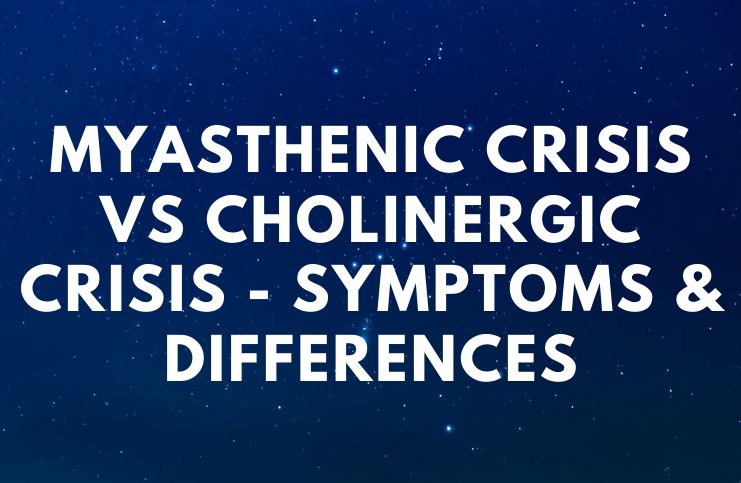Myasthenic Crisis vs Cholinergic Crisis – Symptoms & Differences:
Myasthenic Crisis (MC)
It is a complication of a condition known as myasthenia gravis, a chronic autoimmune disorder that is characterized by rapid fatigue and weakness of voluntarily controlled muscles.
MC is a life-threatening medical emergency requiring early respiratory assistance and diagnosis.
MC may be triggered by stress, surgery, infection, or an adverse reaction to medication and typically requires immediate medical attention since, in this state, the respiratory function should be monitored closely for evidence of respiratory failure.
In addition, ventilatory support should be initiated in the setting of emerging respiratory failure.
The median time to first MC from the onset of myasthenia gravis ranges from 8 to 12 months. An estimated 15 to 20 percent of myasthenic sufferers are affected by MC at least once in their lives. Also, the median duration of the crisis episode is around 11 days.
Symptoms
The following are common MC symptoms:
- weight loss;
- difficulty speaking or breathing;
- trouble chewing;
- trouble swallowing;
- a weak cough with increased secretions (saliva or mucus);
- weak tongue;
- feeling unrested during the day;
- daytime fatigue;
- frequent nighttime awakenings;
- morning headaches;
- the skin around your neck, between your ribs, or on your abdomen pulls in when you breathe.
Risk Factors
Any of the following may increase your risk or trigger for an MC:
- some contrast dyes that are used in imaging tests, like – magnetic resonance imaging
or computed tomography scan; - lung infections, like – pneumonia;
- emotional upset;
- colds, coughs, or fevers;
- stress from surgery or trauma;
- pregnancy;
- monthly periods;
- a tumor of your thymus (a gland in your chest);
- a change in medicines;
- thyroid disease;
- aspiration pneumonitis caused by breathing in vomit or stomach acid.
READ MORE: Orange Triad vs Animal Pak
Cholinergic Crisis
Cholinergic crisis (CC), also referred to as mnemonic “SLUDGE syndrome,” is a clinical condition that occurs as a result of the overstimulation of muscarinic and nicotinic receptors at the neuromuscular synapses and junctions due to an excess of acetylcholine.
Acetylcholine is an organic chemical that functions in the body and brain as a neurotransmitter. It is stored in vesicles at the ends of cholinergic neurons.
CC causes profound weakness due to continuous depolarization of the postsynaptic membrane (the membrane that receives a signal from the presynaptic cell and responds via hyperpolarisation or depolarization), that in turn results in a depolarizing type of neuromuscular blockade.
Symptoms
Some of the symptoms of increased cholinergic stimulation include:
- stimulation of skeletal muscle (due to nicotinic acetylcholine receptor stimulation);
- stimulation of the salivary glands;
- stimulation of the pupillary constrictor muscles;
- vomiting;
- smooth muscle tone changes causing gastrointestinal problems, like cramping;
- contraction of the detrusor muscles;
- relaxation of the internal sphincter muscle of urethra;
- stimulation of the lacrimal glands.
Causes
Some of the causes of the cholinergic crisis include post-surgical overdosing of cholinesterase inhibitors and exposure to nerve agents intended to reverse residual muscle paralysis.
However, the most frequent cause of CC is the unintended overdose of treatment drugs in myasthenia gravis sufferers.
READ MORE: Texas Pete vs Frank’s
Risk Factors
In clinical practice, a cholinergic crisis is most commonly seen in:
- exposure to a chemical substance that causes the inactivation of acetylcholinesterase (the primary cholinesterase in the human body). Examples of such substances are nerve gas such as – tabun (the first nerve agent chemical weapon to be discovered), sarin (a highly toxic synthetic organophosphorus compound), woman, and other organophosphates including insecticides and pesticides;
- suferrers after general anesthesia who received high doses of acetylcholinesterase inhibitors (a chemical which inhibits the acetylcholinesterase enzyme from breaking down acetylcholine) to reverse the effects of neuromuscular blocking agents;
- people with myasthenia gravis on the medical treatment with high-dose acetylcholinesterase inhibitors.
Treatment
The respiratory compromise from CC has no pharmacologic therapy or solution since atropine blocks muscarinic acetylcholine receptors, but it will not improve the muscle ability and strength to breathe.
Therefore, such a patient will need mechanical ventilation support until the crisis resolves on its own. Furthermore, other elements of CC can be treated with antimuscarinic drugs such as atropine.
READ MORE: Prevagen vs Focus Factor
Bottom Line – Myasthenic Crisis vs Cholinergic Crisis
Myasthenic crisis is a life-threatening condition, that is defined as weakness from acquired myasthenia gravis.
MC is severe enough to necessitate intubation. It can affect between 15 to 20 percent of all patients with generalized autoimmune myasthenia gravis. Myasthenia gravis is an autoimmune disorder that is affecting neuromuscular transmission and is leading to localized or generalized weakness characterized by fatigability.
Management in the intensive care unit and ventilator support are the most important components in the management of a myasthenic crisis.
A cholinergic crisis results from an overdose of acetylcholinesterase inhibitors (these drugs increase the concentration of acetylcholine at the synapse and improve attention, behavior, and memory).
Some of the CC symptoms include hypotension, bradycardia (a slower-than-normal heart rate that can cause numerous symptoms), miosis, and a characteristic outflow of bodily fluids such as excess salivation, lacrimation, diarrhea, and bronchial secretions.
In medicine, a cholinergic crisis is usually observed in some surgical cases, when too high a dose of a cholinesterase inhibitor is given to reverse surgical muscle paralysis or in people with myasthenia gravis who take too high a dose of their cholinergic treatment medications.
A CC should be treated by mechanical ventilation (if required), withdrawing all anticholinesterase medication, and atropine i.v. for muscarinic effects of the overdose.
READ THIS NEXT: NeuroCore vs C4
References https://www.ncbi.nlm.nih.gov/pubmed/29907949 https://www.ncbi.nlm.nih.gov/pubmed/23956564 https://www.ncbi.nlm.nih.gov/pmc/articles/PMC3724074/ https://www.sciencedirect.com/topics/nursing-and-health-professions/cholinergic
